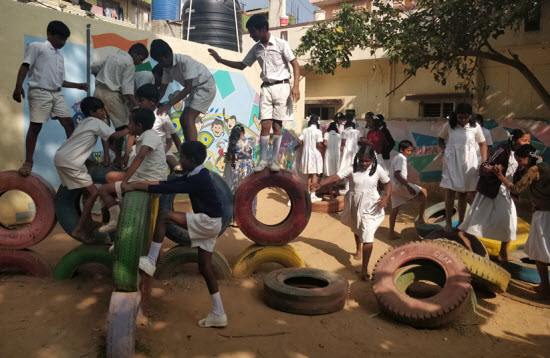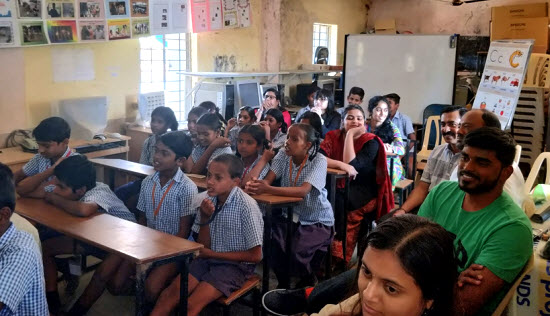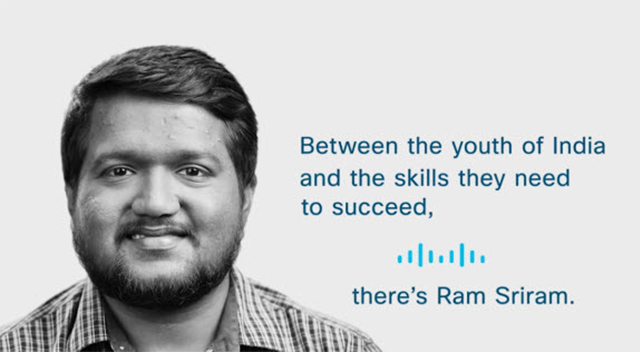2019-October-05
Did you know? You can share this story using the social media icons on the upper left. Use the hashtag #WeAreCisco. You can also rate or comment on the story below.
Teaching English to Keep Kids in School
BY RAMACHANDRAN SRIRAM · GLOBAL PROCESS OWNER, SUPPLY CHAIN OPERATIONS · BANGALORE, INDIA
Ram joined Cisco as a newly minted University graduate in 2017. He’s an engineer with a teeming curiosity to learn how businesses function, so Supply Chain Operations felt like a perfect fit. Cisco was a dream for him because of our culture of giving back. Giving back is a way of life for Ram, who grew up watching his parents constantly trying to help improve society.
When he was young, Ram spent some weekends helping his parents prepare food at an old-age home. Other weekends, he’d sit in classes watching his mother teach arithmetic to underprivileged children. Through those early experiences, Ram learned that giving back is more than just donating money to a cause; it’s also committing yourself to a purpose.
Imagining an Escape from Poverty

Did you know India has about as many official languages as all the countries have in the European Union put together? This makes some things complicated, such as early education.
In the regional government-led primary schools, children are originally taught in the local regional language. By the time students enter secondary schools, curriculums are entirely in English, a language they’ve never been exposed to.
For hundreds of thousands of kids, education offers a small possibility to escape a life of poverty. Even if a child manages to enroll in primary school, a lack of English fluency impedes any post-primary education. This nightmare is a reality for many children belonging to the urban poor in Bangalore, the capital city of Karnataka, India.
The language gap leads to a myriad of dropouts between the primary and secondary schools. Most of these students are first-generation learners. Because their parents are day-laborers, they’re encouraged to leave school to start work as an extra source of family income.
While some organizations like Akshaya Patra provide essential midday meals for hungry students, the root cause for the dropouts is the language barrier. So how could we keep those kids in school?
Building a Solution Together

Fortunately, the folks in our Supply Chain Operations organization love to devour challenges for breakfast, lunch, and dinner. Growing up in India, not a single person in my team of 50 volunteers was oblivious to the sufferings of folks around us. We realized that we are the fortunate ones — able to live comfortable lives, working for a company like Cisco.
Drawing help from a nonprofit called Step Up For India, and the kind-hearted folks from the Community Relations team, we created a solution.
We built a curriculum for a foundation course in English to help close the language gap. It’s offered similarly to how kids learn their mother-tongue — through phonetic sounds, songs, rhymes, and stories.
Using our curriculum, my volunteers from the Supply Chain India team were able to be the bridge between primary and secondary schools, for the hundreds of kids in government schools near the Cisco Bangalore office.

Putting the Solution into Practice
The program is structured around four semesters over two academic years. Students are introduced to letters, words, sentences, and paragraphs in respective semesters.
We go to the school for an hour-long class in the afternoons. We sing with the kids and read aloud with them, slowly forgetting the stresses of our day as well.
The few hours we spend with the children every month snowballs into something bigger. Our course gives these kids a chance at a future that they’ve been denied so far. If these kids escape the viciousness of poverty, so can their families. And that also trickles down to future generations.
“Become Like the Cisco People”
We’ve had more than 50 volunteers teach 400 to 500 students during the past two years. That’s 500 children with new hope for their future. Kids who had resigned themselves for a life in the quagmire of poverty now start to dream.
Their dreams are still hazy, but the joy you feel is incomparable when you ask some of them their future ambitions: “We want to become like the Cisco people.”
Do the children know what people at Cisco do? Or what they need to do to get there? Most likely not. But what they see in “Cisco people” is a life outside of their struggles to make ends meet. A life where they have an opportunity to stand on firm footing and then give back themselves.

Start Small, Change the World
I’m particularly passionate about alleviating poverty. It’s extremely disheartening when you learn that in a developing country, a kid born in poverty most likely lives his entire life in poverty.
If I could volunteer full time, I’d most likely study poverty traps and develop guardrail frameworks to help people escape. Education is one of the easiest escapes out. It empowers these kids with an opportunity they never had. And that’s the primary reason why our whole team of volunteers is extremely driven with our program.
Just like us, you can make a difference too. You don’t necessarily need to have a eureka moment or a big idea to change the world.
You can start small, one life at a time. Before you know it, we’ve changed the world for the better.
Connect everything. Innovate everywhere. Benefit everyone.
Share your thoughts!
Log in to rate and commentShare your thoughts on the story here!